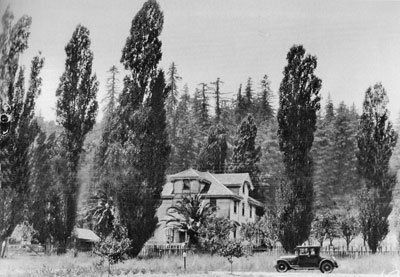
It would be nearly impossible to miss the mounds of soil being moved or the chewing into the hillside along Scotts Valley Drive where a 49-home development is taking shape.
But not so long ago, the former sand quarry and site of the RVs of Merritt dealership that will soon be known as the Woodside development was a quiet ranch along a dirt road with no neighbors in sight.
Turn back the clock 100 years to 1912, and much of what is now the Scotts Valley Drive section of Scotts Valley was 750 acres of dairy land owned by three brothers — Edward, George and John Frapwell.
At the center of that vast tract of land — and located where the RVs of Merritt showroom once stood — was a massive three-story, 19-room Victorian-style mansion along what was then called the Glenwood-Santa Cruz Road.
Built in 1892 by the ranch’s original owner, English native William J. Thomson, the mansion was the center of a bustling ranch that boasted gardens, vineyards, fruit orchards, two barns, a dairy, a blacksmith shop, smokehouse and pens for cattle, pigs, sheep and chickens.
Sold to the Frapwell family in 1911, the ranch continued raising cattle and hogs as well as cutting and delivering firewood to the Casa Del Rey hotel in Santa Cruz until sometime in the 1920s.
The history is according to a 1990s account of the property by Elvis Frapwell in the late Dr. Donald Seapy’s book, “Scotts Valley: As It Was and As It Would Become.”
The mansion, however, was sporadically occupied after an aging Edward Frapwell constructed a smaller home near Carbonero Creek in 1924, a structure that still exists near the site of LightSpeed Martial Arts Academy.
The Frapwells rented the mansion occasionally after 1924, but by 1934, the mansion was being used for storage.
It was in 1934 that then-10-year-old Marie Bowe moved into the venerable house with her family.
Bowe, who has lived in the Seabright neighborhood in Santa Cruz since the late 1940s, said that her father — a truck driver — made an arrangement with the Frapwells to live rent-free in the old mansion in exchange for cleaning it.
“The house had been vacant for some time,” she said during an interview at her home last week. “It was just used for storage.”
The first thing Bowe remembered seeing when she and her family stepped inside the old Victorian for the first time was jarringly out of place.
“A big, beautiful living room, filled with corn shucks,” she said. “It hadn’t been used or lived in for a long time”
Bowe vividly remembers the dark mahogany used in the house’s woodwork, as well as the view from the mansion’s parlor.
“The doors were all beautiful stained glass,” she said. “Every room was painted a different color.”
Bowe and her family spent much of the next year cleaning the house’s 19 rooms, moving their belongings in one room at a time, while she attended fifth grade in the two-room schoolhouse located where Scotts Valley Middle School now stands.
Bowe said her family lived in the mansion for a little less than a year, moving out when the Frapwell family decided to take the house back for a relative.
She looks back on the house fondly, and remembers exploring the narrow staircase that ran up the back of the house from the kitchen to the attic with her siblings.
“(The mansion) would’ve been beautiful all fixed up,” she said. “It was pretty once we got it cleaned up.”
Remembering the past
As the construction of the Woodside townhouse development’s 49 homes progresses, members of the Scotts Valley Historical Society are seeking ways to preserve the memory of what used to be, including recollections like Bowe’s.
The Thomson-Frapwell mansion is long gone — demolished in 1969, just before it could be designated as a National Historic Landmark. Part of the former ranch was carved up into a sand quarry in the 1950s.
The historical society expressed hope that the new development would acknowledge the history and heritage of the site in some manner, whether by way of a plaque, street names, or some sort of monument.
“Progress is inevitable,” said Jay Topping, a member of the society. “But before we move forward, we should support and honor our past.”
Jim Sullivan, of Sullivan Land Development, said he was open to some kind of recognition of the site’s agricultural past and was willing to work with the historical society.
“One of the conditions of approval was to work with the historical society over names,” he said. “I think a real nice thing would be right on the south end of our project, could be a plaque or a nice, permanent monument.”
Sullivan said he had submitted about a dozen historically reflective names to be considered as street names for the roadways in the development, but many were not approved by county and emergency officials because similar road names exist elsewhere.
“I believe 10 of them were names I’d gotten from the historical society,” he said. “I think they might’ve kept one.”
According to Michelle Fodge, senior planner with the city of Scotts Valley, part of the terms of the city’s development agreement with Sullivan also encouraged consultation with the city’s arts commission on ways to make the site as aesthetically pleasing as possible.
Fodge cited the Tree Circus Center as one such example of blending Scotts Valley’s past with its present.
“The community wants to see their city highlighted,” Fodge said. “The goal is to have some reflection of that site’s heritage and its history.”
To comment, email reporter Joe Shreve at jo*@*********er.com, call 438-2500 or post a comment at www.pressbanner.com.











